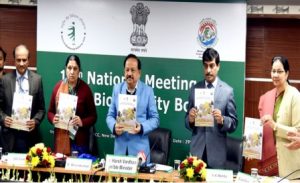India’s Sixth National Report to the Convention of Biological Diversity
The Report highlights that while India has overachieved two National Biodiversity Targets, it is on track to achieve eight targets.
 India has been investing a huge amount on biodiversity directly or indirectly through several development schemes, to the tune of Rs 70,000 crores per annum as against the estimated annual requirement of nearly Rs 1, 09,000 crores as per the Sixth National Report (NR6) submitted to the Convention on Biological Diversity (CBD).
India has been investing a huge amount on biodiversity directly or indirectly through several development schemes, to the tune of Rs 70,000 crores per annum as against the estimated annual requirement of nearly Rs 1, 09,000 crores as per the Sixth National Report (NR6) submitted to the Convention on Biological Diversity (CBD).
Union Environment Minister, Dr. Harsh Vardhan submitted the report to the CBD Secretariat during the inaugural session of the 13th National Meeting of the State Biodiversity Boards (SBBs) organised by the National Biodiversity Authority (NBA) in the Ministry of Environment, Forest and Climate Change (MoEFCC), New Delhi. The Minister also released the document ‘Progress on India’s National Biodiversity Targets: A Preview’ on the occasion.
The NR6 provides an update of progress in achievement of 12 National Biodiversity Targets (NBT) developed under the Convention process in line with the 20 global Aichi biodiversity targets.
“Briefly, the Report highlights that while India has exceeded/overachieved two NBTs, it is on track to achieve eight NBTs and in respect of the remaining two NBTs also, India is striving to meet the targets by the stipulated time of 2020.”
India has also made noteworthy achievement towards NBT in relation to access and benefit sharing (ABS) by operationalising the Nagoya Protocol on ABS. Having published the first internationally recognised certificate of compliance (IRCC) under the Protocol in 2015, India has since published nearly 75 per cent of the IRCCs published so far on ABS Clearing House. Thus, in respect of these two NBTs (6 and 9), the progress made by India has exceeded the targets.
On raising awareness about biodiversity, which is an important thrust area in several programmes of the Government, India harbours nearly 7-8 per cent of globally recorded species while supporting 18 per cent of the global human population on a mere 2.4 per cent of the world’s land area.
Also read: Thoothukudi Sterlite Protest: Another Environment v/s Profit War
Sustainable management of agriculture, fisheries and forests, with a view to provide food and nutritional security to all without destroying the natural resource base while ensuring intergenerational environmental equity is being put into practice.
“Mechanisms and enabling environment are being created for recognising and protecting the vast heritage of coded and oral traditional knowledge relating to biodiversity for larger human welfare while safeguarding the interests and rights of the local communities as creators and holders of this knowledge.”
Programmes are in place to maintain genetic diversity of cultivated plants and livestock towards minimising genetic erosion and safeguarding their genetic diversity.
India has nearly two third of the population of wild tigers in the world. The population of lion has risen from 177 in 1968 to over 520 in 2015, and elephants from 12,000 in 1970s to 30,000 in 2015. One-horned Indian Rhino which was on the brink of extinction during the early 20th century, now number 2400. Further, while globally over 0.3 per cent of total recorded species are critically endangered, in India only 0.08 per cent of the species recorded are in this category.
Submission of national reports is a mandatory obligation on Parties to international treaties, including CBD. Interestingly, India has never reneged on its international commitments and has earlier submitted on time five National Reports to the CBD.
